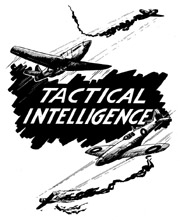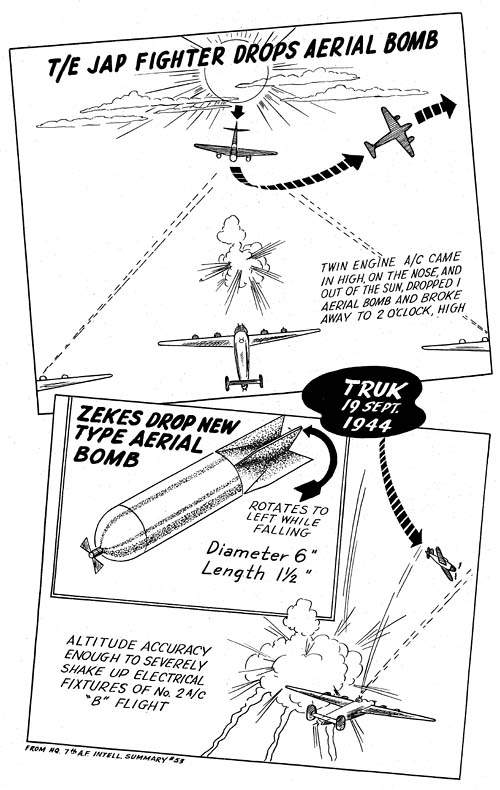 The following tactical intelligence report appeared in “Eastern Air Command Weekly Intelligence Summary”, No. 10, Nov. 3, 1944 published by Headquarters Eastern Air Command, Southeast Asia.
The following tactical intelligence report appeared in “Eastern Air Command Weekly Intelligence Summary”, No. 10, Nov. 3, 1944 published by Headquarters Eastern Air Command, Southeast Asia.
Oscars Drop Aerial Bombs on B-24 Moulmein Mission
22 October Preliminary Report from 356 Squadron (RAF)
Thirteen Liberators (B-24s) dropped bombs on Moulmein between 1159 and 1202 hours from 2000 feet to 2500 feet. Immediately after this attack two enemy aircraft; one Oscar and one Tojo, were sighted at two oclock, 2000 yards away and 500 feet above. One of these rolled off the top and dived through the first formation. (The Liberators were in two formations, 2000 yards apart – ahead and astern.) As it dived, enemy aircraft fired and hitting aircraft “D” inflicted slight damage to that machine’s leading and trailing edges. Enemy aircraft leveled off at 1000 feet.
The second of these two enemy aircraft stood off at 2000 yards then disappeared in the direction of Rangoon, performing aerobatics as it went on it’s way.
Two Oscars (MK II) were sighted 37 minutes after leaving the target area. Standing off, they remained in sight of the squadron for 35 minutes. At 1314 hours in position 1630 N 9500 E these two enemy aircraft split up and attacked simultaneously. The Liberators were now at 10,000 feet.
Attacking from ahead and above, one enemy aircraft dived and dropped what appeared to be aerial bombs which seemed to flutter down slowly in pairs. One bomb burst with a reddish yellow flash in front of and below the Oscar while it was still diving, but no damage was done to our aircraft.
The second Oscar came in level from astern. It closed to 250 yards but did not fire. Two rear gunners and one mid-upper gunner opened lire and tracer from aircraft “J” appeared to enter the Oscar’s wings. Enemy aircraft broke away apparently undamaged….
Jap T/E Fighter Drops Aerial Bomb on Truk Strike
Thirteen B-24s bombed N Moen Airfield, Truk, from 19,500 feet on 19 September 1944. A twin-engine Jap fighter attacked the formation and dropped a phosphorous aerial bomb. (7th AF Intelligence Summary No. 53, 7 October, 1944).
The attack was made at noon and was unescorted. One minute after “bombs away” our planes were intercepted by 3-4 Zekes and one possible Nick. One two-plane coordinated attack was made from one oclock high. Both of these planes dropped aerial bombs, after coming in from out of the sun. This attack was followed by five individual passes from between twelve and two oclock. These fighters also came in high and released three aerial bombs and made two shooting passes. The bombs hit low and wide.
One of our planes had a feathered engine and was subjected to two fairly aggressive attacks from five and eight oclock high. However, the formation protected this plane by slowing down and keeping him well covered.
The twin-engine fighter came in from the nose, high and out of the sun, and pressed his attack to 250 yards. He broke away to the right at two oclock, exposing the belly of the plane. A phosphorous bomb was dropped, bursting approximately 300 yards at three oclock. Although twin-engine fighters have been seen on many previous missions, this aerial bomb attack is the first reported from this type fighter. (Illustration A).
Zekes Coordinate on Aerial Bomb Attack
Fifteen more B-24s hit the same target. (See story above). The attacks were coordinated so that after “bombs away” the two formations gave mutual support. Separate bomb runs split the AA defenses.
Interception of this second formation was started just before the bomb run. Three Zekes made a coordinated attack, two coming in trail from 11 oclock high and the third diving steeply from out of the sun. The first pass was a shooting pass, the second was an aerial bomb attack, and the third was an aerial bomb and shooting pass. The first fighter broke away at 500′ rolling down toward 5 oclock. His trailing wingman also broke off the attack at 500 feet and pulled off toward 3 oclock low. The Zeke that dove out of the sun, reached a position about 600′ in front of the formation but then pulled up and rolled into a spiral breakaway above the formation.
Both of the aerial bombs released in this coordinated attack were a new type. (Illustration B). One of the bombs was observed prior to bursting and was described 1½ feet in diameter, 6 feet long and spinning to the left as it fell. The burst was orange-red and shrapnel was thrown out which looked like tracers. Both bombs were accurate as to altitude. One burst to the left and one to the right of the formation. One burst was close enough to No. 2 plane in B-Flight for the blast to jar loose lighting fixtures in the cockpit.
All other passes were very unaggressive. The mission was notable since after leaving the target, all 27 planes offered mutual support instead of the two formations leaving separately. The 431st crew members expressed the opinion that this may have been responsible for the unusually unaggressive tactics on the part of the enemy pilots. No damage to our aircraft resulted from enemy fire.
- “Aerial Bombing Attacks on Aircraft“, Tactical and Technical Trends, No. 26, June 3, 1943.
- “Japanese Aerial Burst Bombs“, Tactical and Technical Trends, No. 47, June 1, 1944.











This is interesting; I knew the Germans tried this form of attack on bombers, but this is the first time I’ve heard of the Japanese trying it.
The mention of the bombs falling in pairs makes me wonder if there was some sort of a cable connecting them that was supposed to get caught around the bomber’s wings or props, pulling the bomb into contact with the plane where it would detonate.
There is a well-known picture of one of the phosphorous bombs bursting near a B-24.
http://www.historyofwar.org/Pictures/japanese_phosphorus_bombs.jpg
Thanks for the link…that’s really something to see!
I imagine they were hoping a chunk would end up in one of the engine nacelles and set fire to the engine.
Hello, just browsing for information for my Tamiya site. Can’t believe the amount of information out there. Wasn’t what I was looking for, but good site. Cya later.
Good layout.